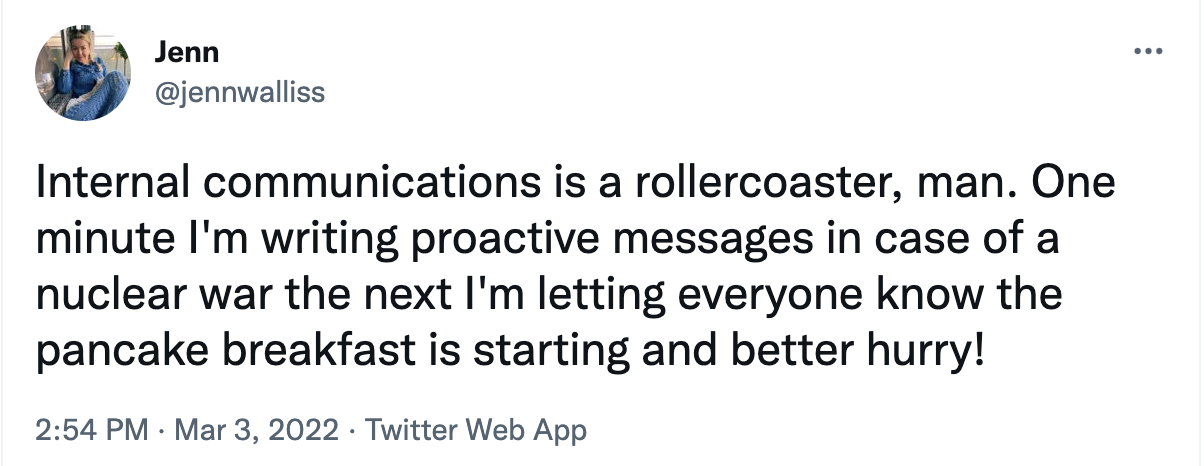Let’s face it. The last two years have been difficult.
From the continued pandemic, political polarization, and the war in Ukraine with its accompanying humanitarian crisis, to the ever-worsening effects of climate change and the controversial Roe v. Wade ruling in the United States. And then, of course, there’s an economic downturn and the looming recession.
Who hasn’t been impacted by the calamitous world events of the 21st century?

All these crises are hard to comprehend, and they have affected employees and companies in different ways.
Internal communicators have been in the thick of it all, burdened with the unenviable task of communicating generally bad news.
You may have had to pivot your comms strategy to reflect a newsroom model, reporting as events unfold. Or maybe you're even preparing messages ahead of time, such as many did following the leaked draft of Roe v. Wade in May 2022. And what makes your job all the more difficult is the fact that the timing of global events is often unexpected and jarring.
So how have communicators been juggling the demands of these harsh realities with their company’s response, employee concerns, and, most importantly, the anxiety caused by it all?
Three internal communications experts taught us their methods of dealing with anxiety about world events, and how they handle their own anxiety in these uncertain times.
Here's what they shared:
Denisa's method: Root your communication in meaningful action — not empty words

It’s important to have a balance between addressing world events and acknowledging the anxiety surrounding them with compassion, curiosity, and care — and being intentional about creating needed reprieves from the constant stream of bad news."
Denisa Orlandea
Denisa Orlandea, Manager of Internal Communications at Seaspan ULC, tells us that when considering whether or not to communicate a particular world event, there are three things to keep in mind:
1) Determine the relevance of the event to your internal audience. If the news is indeed relevant, you can then tailor your messaging in a way that is meaningful for employees.
2) Is the event impacting an area where the organization (or its customers) operates? In today’s hyper-connected world, sometimes the impact of an event isn’t as obvious as we might believe.
When in doubt, consider the demographics of your employee base. At first look, an employee based in North America might not be directly impacted by an event like the war in Ukraine. However, some employees could have family ties to Europe that cause great anxiety.
Denisa makes it clear that not every single world event can or should be addressed by every organization. But if an event impacts the organization and is also relevant to the employee base, your communication response should be rooted in meaningful action instead of empty words.
3) More and more, company leaders are regarded as trusted sources of information. This goes hand-in-hand with employee expectations that their organizations will speak on societal or global events. And if a company is seen as a trusted source of information, its communicators will have more responsibility to hold that company accountable.
Andrea's method: Listen and understand your employees
Andrea Greenhous is the President and Chief Internal Communications Strategist at Vision2Voice Communications. She reminds us that although anxiety about world events can severely impact employee well-being and the ability to thrive in the workplace, this impact will not be the same for everyone.
Andrea emphasizes listening as a key tool for understanding how individual employees will react.

I believe one of the most important roles internal communications professionals play is to listen and understand people in your organization. We don’t do it enough. Listening can and should take many forms, but should largely depend on what’s most comfortable for employees.
Andrea Greenhous
Humans are capable of feeling thousands of emotions for different reasons, so communicators should embrace this fact and acknowledge individuality. Responding to a world event as though everyone is feeling the same isn’t appropriate. Plus, people have their personal problems to manage. If an employee is struggling financially or their loved one is dying, they're probably less focused on the news.
But still, there are major world events — like climate change or war zone atrocities — that will likely impact many people and raise questions about how an organization should respond.
If a company is directly affected by world events, internal comms professionals can find themselves in a challenging position. Communicators need to keep individual empathy in mind when crafting messages. But they’re also charged with helping employees understand how events will directly affect their organization’s future. So Andrea recommends communicating cautiously, with all possible stakeholders in mind.
Shaun's method: Respond candidly and authentically

Employees who are anxious and scared can smell bullshit. Honesty is the best policy, communicated on a frequent, non-annoying basis.
Shaun Randol
Shaun Randol is the founder of Mister Editorial and has joined us this Summer of Self-Care for our Linked-In Live on Practical Tips for Mental Health. He focuses on authenticity in internal comms.
Wherever possible, Shaun tells us, leaders and communicators alike should respond candidly and in ways that are authentic to them.
Showing some vulnerability always wins points with employees and gives them a chance to both sympathize and empathize. This will help employees understand the situation and gain the organization some extra time to manage a crisis.
In-person meetings give employees the opportunity to read their leader’s body language. In virtual live sessions, the camera should be zoomed out and include more of the speaker’s body for the same reason.
Shaun reminds us that employees have their unique, individual struggles. They are concerned about layoffs and recession. Regardless of what is happening in the news, they want to know whether their job and livelihood is at risk.
Communicating about the state of the business will always be more important than commenting on anything that’s happening outside the workplace. It’s internal comms 101. That said, news directly concerning employees will get increased attention.
Despite the rising trend to trust in companies commenting on global news, internal communicators must be concerned first and foremost with the business. It's simple: employees have bills to pay, so prioritize your messages accordingly.
How can you best handle employee anxiety about world events?
The airlines have it right: we should be putting our own oxygen mask on first before helping others. We can’t care for others if we don’t care for ourselves, and we can only do our best work when we are healthy and rested.
Denisa Orlandea
The first step is to gain a good understanding of how employees feel on topics that may lead to more widespread anxiety. Denisa recommends monitoring trendlines from pulse surveys to get a read on changing anxiety levels within an organization over time. The key is to create a culture where employees feel safe to share their experiences and anxieties.
Setting expectations for communication rhythms during stressful times can help address some of the anxiety. Knowing that there will be a set time or channel to receive updates or ask questions can go a long way. Good communications provide opportunities for mechanisms and channels to collect data and feedback that reveal a company’s pulse.
However, the best way to learn how employees feel will always be through high-touch approaches such as personal check-ins between managers and their teams. Alternatively, you can collect feedback from Employee Resource Groups (ERG) across the organization. Overall, internal communications professionals should approach high-anxiety situations from a place of empathy, curiosity, and learning.
I think that the most important approach is to make sure managers are equipped to have open and psychologically safe conversations with their people. This is how you drive an individual and personalized approach.
Andrea Greenhous
Andrea sees purpose as a north star that can guide people through uncertainty while rallying people around a common goal. A study by Frontiers in Psychology shows that an organization’s purpose is closely linked with an organization's accountability and societal responsibility.
Purpose-driven leadership incorporates and represents the employees’ personal beliefs. This in turn motivates them in times of uncertainty. During times of global distress, this is important for generating morale and focus. The knowledge that one's purpose is aligned with organizational goals (e.g. fighting climate change with low-carbon alternatives) can help reduce anxiety.
Andrea also stresses the importance of culture: Nurturing a high level of psychological safety and building a learning and growth mindset can help prepare organizations for change. The fact that we live in a VUCA (volatile, uncertain, complex, and ambiguous) world means that organizations and people will need to continue to learn, change, and adapt.
Anticipate and plan when watching the news. Shaun points out that the overturning of Roe v. Wade was in the news for weeks before a decision was made. Russia was setting up its military at the Ukrainian border for months before the invasion. He sees it as a communicator’s job to keep on top of things and have a response prepared.
Anyone who watches the news should not be surprised about major issues. Being prepared helps you manage the emotional moment; you can move directly into execution mode rather than trying to figure it all out on the spot.
Shaun Randol
Communicators should keep working with worst-case scenarios in mind, and prepare statements accordingly. Being prepared for the worst helps communicators keep a clear head and avoid rushed mistakes.
How do internal communicators best cope with their own anxiety about world events?
We need to be better at taking our own advice and to listen to those well-crafted resources on well-being and mental health that we put together for our audiences.
Denisa Orlandea
It should be made clear that communicators are as much the audience of their communications as the people they are communicating with and for.
Denisa reminds us that in times of VUCA, communicators are impacted by world events as much as the next person. On top of their own anxieties, communicators need to anticipate the impact these events are likely to have on their organizations and clients. The stress adds up.
One solution to coping with this stress is to acknowledge your feelings and give yourself grace. This is crucial to protecting your mental health at work.

Andrea is a great believer in the power of the human spirit and tries to focus on what she can control and what she is grateful for. When confronted with global problems like climate change, she will try to find ways in which she can take action and make a difference. There are always solutions to problems — even those as overwhelming as global warming.
The key is to start looking for solutions that we can undertake directly. When the war in Ukraine began, Andrea took some time to process and research ways in which she could help. She talked to her team and created a safe space to communicate fears and anxieties.
It hit me quite hard because my grandmother was Ukrainian and I’d been trying to track down family members — there was part of me that ached with the realization that distant relatives were living through that. I watched, I learned, and I let myself be unproductive for a few days.
Andrea Greenhous
To be able to communicate appropriately and juggle all the different stakeholders’ demands, communicators must first take a deep breath and focus on their own worries. This is not always easy but it's a step that needs to be taken.
How do you want to respond to world events?

Internal communications will always be a mixed bag of messages.
One moment, you’re communicating everyday business messages — like the results of a survey or organizing internal town halls. And the next thing you know, you’re navigating external news that might influence the company in unforeseen ways, be they positive or negative.
Finding the right balance between all the different demands requires time and effort. Good communication is a craft and experts should be aware that their greatest asset is their own mental health.
It starts with how communicators handle their own anxieties about world events. The next crisis is always waiting around the corner. The question remains: how do we want to respond to it?
That's why we've put together mental health resources for you:
- Sign up for our resilience email course, put together by Ralf Junge-Pearl, Head of Content at Staffbase and a certified resilience trainer. You'll receive four emails on how to understand your emotions and reactions to stress and, ultimately, how to protect your mental health at work.

- Check out our LinkedIn Live recording on this very topic — how IC pros can deal with anxiety from world events — with Denisa, Fiona Hatton, communicator and yoga teacher, and Emily Stanislaus, Senior Content Strategist at Staffbase.
- Continue the conversation in Comms-unity, our Slack group for internal comms pros from around the world. Join the #mental-health channel to share your thoughts. What's your method for communicating world events and dealing with anxiety?
- Find all blog articles of our Summer of Self-Care here.




